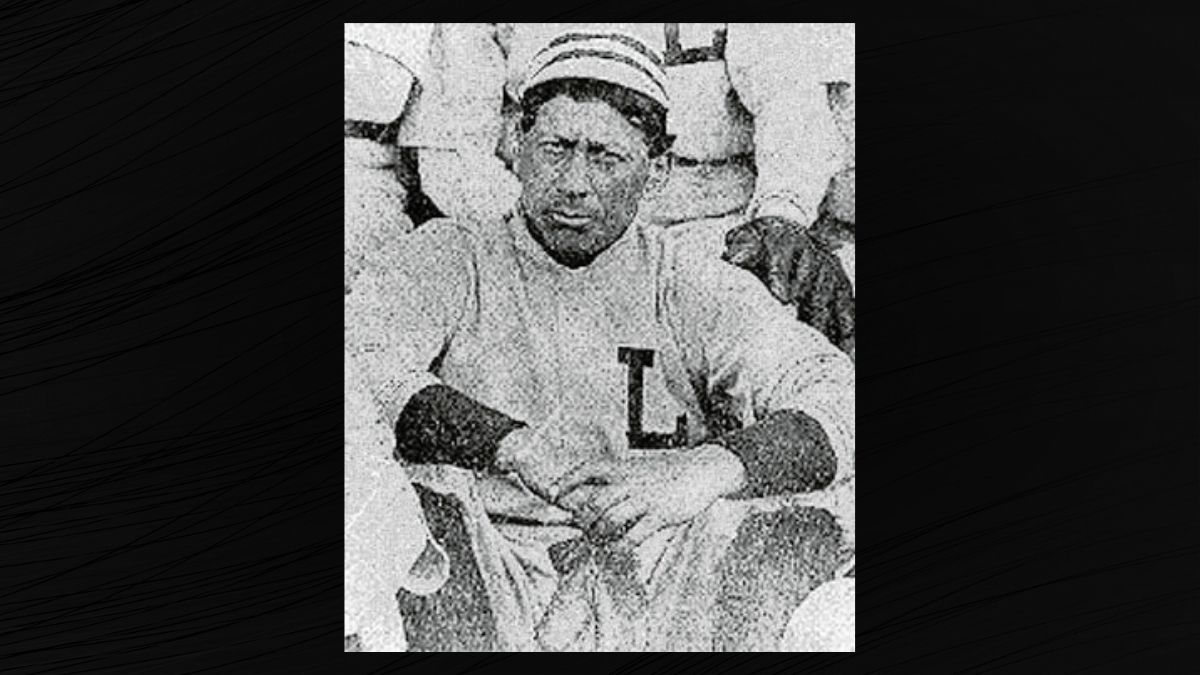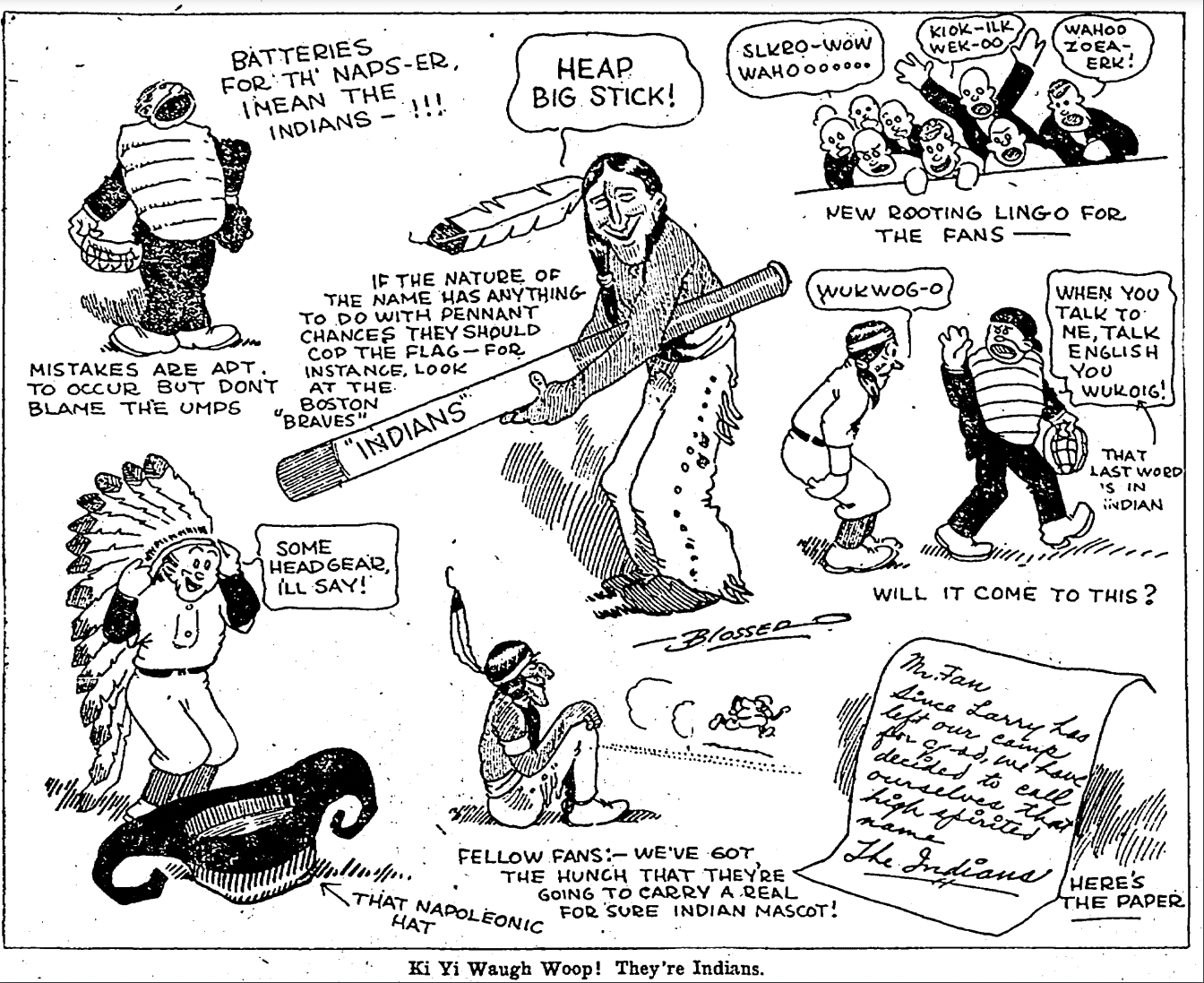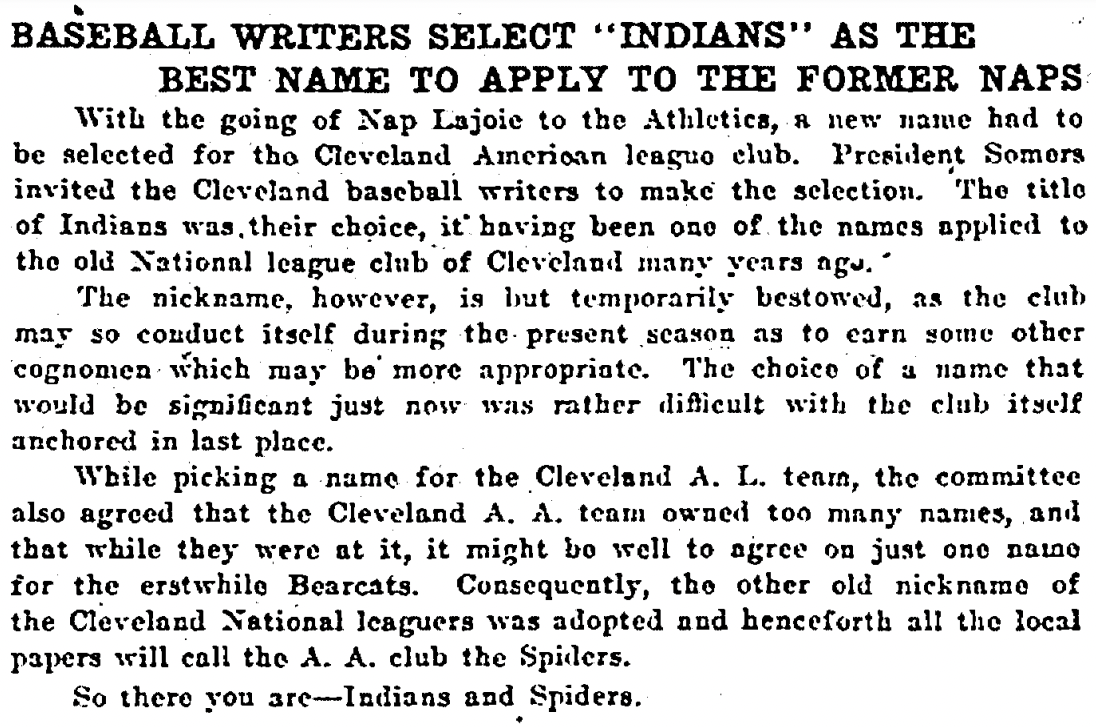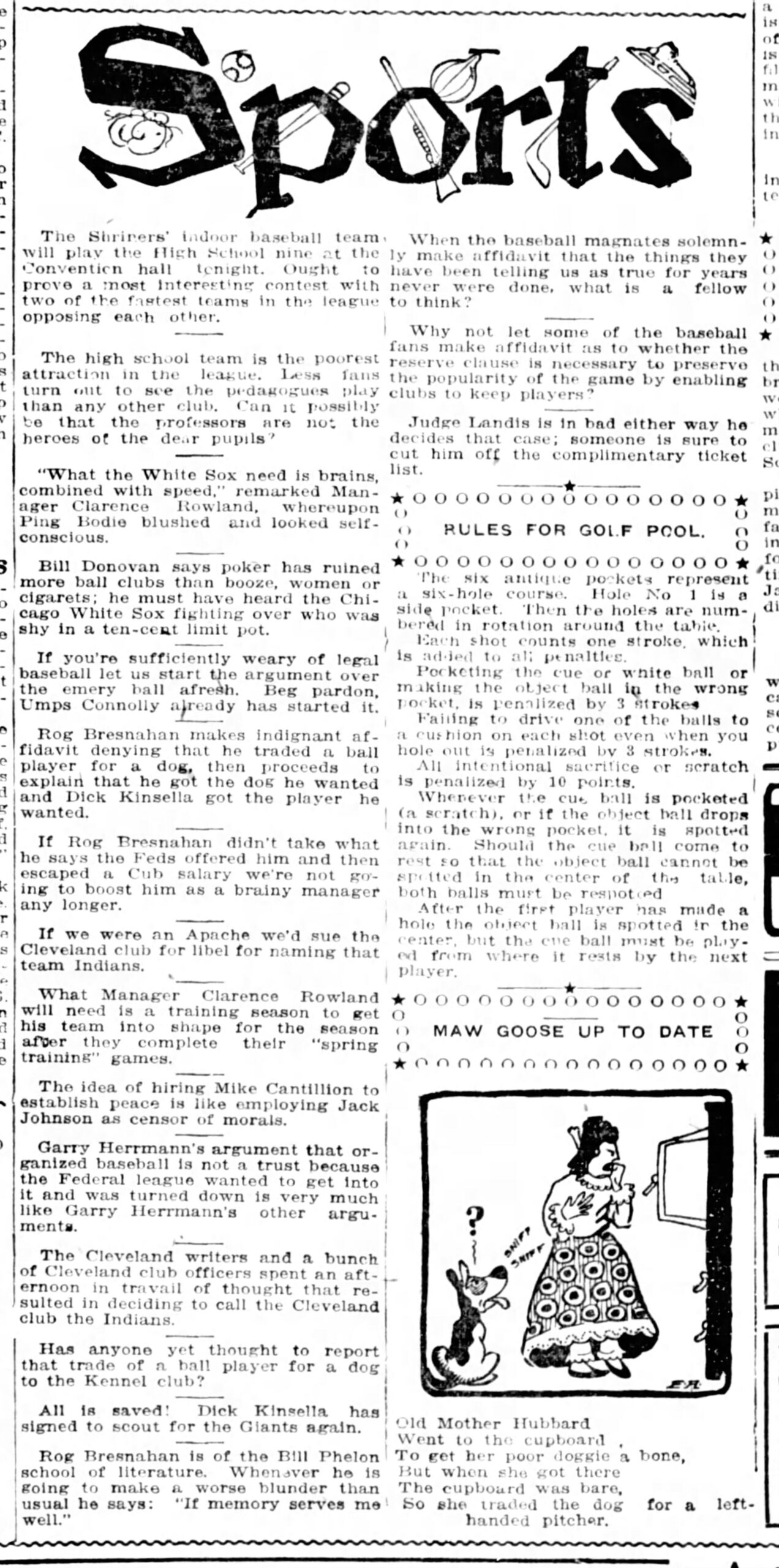The Cleveland Indians baseball team has, over the course of its recent history, associated its official name with Louis Sockalexis. His presence on the team in 1897 was the genesis for the unofficial past nickname for the team, and some accounts say the official name change to "Indians" in 1915 "honored" him. However, the publicity surrounding that name change only fleetingly recognized Sockalexis, whose name was mentioned in only one editorial. As the first known Native American player in the major leagues, he was frequently subjected to racism and abuse, and the newspapers that played a role in selecting the new name for the team were part of the problem.
In December 2020, the baseball team then known as the Cleveland Indians announced they would be dropping the “Indian” from their name, and would be renamed “the Guardians.” Just a year earlier, they also dropped their mascot, known as “Chief Wahoo,” after criticism from Native American activists that it was racist and offensive.
However, many claim the Cleveland Indians name was chosen to honor their own former team member, Louis Sockalexis, who is believed to be the first known Native American to play in major league baseball. A July 2021 letter to the editor of The Wall Street Journal cited a 1915 article, stating that the name was chosen “in honor of former player Louis Sockalexis, a Penobscot Native American from Maine.”
As the Cleveland Plain Dealer editorialized on Jan. 18, 1915: “Many years ago there was an Indian named Sockalexis who was the star player of the Cleveland baseball club. As a batter, fielder and base runner he was a marvel. Sockalexis so outshone his teammates that he naturally came to be regarded as the whole team. The fans throughout the country began to call the Clevelanders ‘the Indians.’ It was an honorable name, and while it stuck the team made an excellent record. It has now been decided to revive this name.”
Even a bill adopted in 2009 by the Maine legislature, titled “Joint Resolution Memorializing Certain National Private Entities to Honor Maine Baseball Great Louis Sockalexis and to Afford Appropriate Respect to Native American Athletes,” said that he was “without question, the inspiration for the team name Indians.”
The newly named Cleveland Guardians’ website, however, is more vague on the history, stating, “Cleveland took on the name 'Indians' in 1915, reviving a nickname of its old NL club upon the arrival of this Native American in 1897. Hall of Famer John Montgomery Ward referred to Sockalexis as 'a marvel.'”
The above Cleveland Plain Dealer editorial mentioned in the Wall Street Journal is indeed real. As per a digitized version we found through the New York Public Library, it was published on Jan. 18, 1915. It continues:
It has now been decided to revive this name. The Clevelands of 1915 will be the ‘Indians.’ There will be no real Indians on the roster, but the name will recall fine traditions. It is looking backward to a time when Cleveland had one of the most popular teams of the United States. It also serves to revive the memory of a single great player who has been gathered to his fathers in the happy hunting grounds of the Abenakis.
Sports writers would go on to debate how much the name was “honoring” Sockalexis. While the baseball team’s name, “Cleveland Indians,” was often connected to Louis Sockalexis during his lifetime (and even after his death), it wasn’t as benign as the claim and the editorial would have us believe.
Louis Sockalexis is considered to be the first recognized Native American player in major league baseball. He was a Penobscot Indian from Maine, who played baseball in the 1890s. In 1897 he played for the team that was then known as the Cleveland Spiders. But Sockalexis spent only three seasons with the team, before his alcoholism resulted in a decline in both his career and his health. He was let go in 1899, and coached youth teams and played in minor leagues. He died in 1913 from heart disease and tuberculosis.
And even though many appear to have memorialized him since, his time playing was marred by racism and abuse. While the one newspaper editorial called for his commemoration in 1915, the same newspaper was part of the racist abuse. The Atlantic reported that the Cleveland Plain Dealer printed one of the first reports about the name change, alongside plenty of racist language and a racist cartoon caricature. The headline reporting the name change on Jan. 17, 1915, said, “Ki Yi Waugh Woop! They're Indians.”
The accompanying article to the cartoon didn't even mention Sockalexis:
Ed Rice, a reporter from Maine, who wrote “Baseball's First Indian: The Story of Penobscot Legend Louis Sockalexis,” told the Bangor Daily News: “It is inspired by Louis, but for all the wrong reasons. When fans remember that nickname from the 1890s again in 1915, when it’s chosen as the official team name, it’s because of him. And more likely, people probably didn’t actually remember Louis in 1915, but they remembered that nickname for the team.”
He goes on to explain the murky origins of the team name in more detail on his website:
Nicknames were a capricious matter in these early days; with merchandise and programs and yearbooks still many years away, it really didn’t matter what a team’s nickname was from year to year. Yes, some teams, early on, settled on nicknames that stuck, like Baltimore’s Orioles or New York’s Giants. But most, like Boston, went through monikers like the Beaneaters and the Pilgrims, before arriving at a permanent nickname (Boston became the Red Stockings or Red Sox in 1908).
The early use of the nickname, before it become official, Rice argues, originated from racism:
The fact of the matter is it was Louis Sockalexis’s mere presence at Cleveland spring training in 1897 that inspired the local sports writers to join in the outright, prejudicial hoopla, dropping the nickname “Spiders” and dubbing the club “Indians” in their newspaper accounts in exhibition games in March. This was surely in recognition of the circus-like atmosphere the appearance of the so-called “full-blooded” (he wasn’t) Indian Sockalexis was going to create all around the league.
However, when Sockalexis was spectacular over the course of the first three months of the season (third-leading hitter in the entire league, featuring several long home runs in the so-called “dead ball” era, 16 stolen bases and well-publicized spectacular catches and awe-inspiring throws to throw out baserunners), he made the nickname into something of a racial, backhanded compliment.
Newspaper verbiage was flat-out racist, with Sockalexis frequently called “a savage” and often chided in the most derogatory of stereotypic terms. Take a look at his game-by- game critiques, and any empathetic reader will come to recognize how all alone Sockalexis was and how begrudgingly he won respect from that press, his fellow players and fans in every city of the league.
In a 2014 investigation for NBC Sports, Joe Posnanski, a sports journalist, also described the kind of abuse Sockalexis faced, “There was hardly a mention of Sockalexis that did not include some reference to collecting scalps or wampum or General Custer or, in later coverage, firewater. War whoops followed him everywhere. The favorable stories usually involved some sort of bizarre Indian tale.”
So how did this nickname that started as a mockery, transition to becoming the official name?
According to Rice, numerous names preceded it:
First known as the Forest Citys, the Cleveland team became the Spiders in 1889 and the Indians in 1897, followed by the Exiles or Misfits in 1899, a season of record ignominious achievement when the team lost a still-record 134 games. In the early 1900s the team was nicknamed the Blues or Bluebirds, for the color of their jerseys, and then the Bronchos. Finally, following a fan contest in 1903, the team adopted the nickname of “Naps,” in recognition of the popularity of Napoleon “Nap” Lajoie, the club’s playing captain and future Hall of Famer.
Lajoie left in 1914, and they had to find a new name. Cleveland owner Charlie Somers asked representatives from four newspapers covering the team to get together and decide on a name to replace the “Naps,” in the hopes that they could finally settle on a more permanent one, according to Posnanski’s investigation. Posnanski and Rice both state that the sports writers chose the name Indians.
Rice wrote, “Sockalexis was not mentioned in any of the news accounts or that large cartoon in the Cleveland Plain Dealer, announcing the adoption of the new name.”
Posnanski, citing the racist language and cartoon used in the coverage of the “Cleveland Indians” name change, said that Native American names were in vogue at the time, it was an opportunity to make jokes at their expense, and there were no references to Sockalexis in the coverage at the time:
One: A year earlier, the Boston Braves had a miraculous season — coming from last place on July 4 to win the pennant — and so Native American names were in. Two: It was a glorious opportunity for HI-larious Native American jokes and race-specific cliches and insults that fit well in headlines. [...]
You will notice there is no mention in this cartoon of Louis Sockalexis, nor was there in any of the national stories about the name change. In fact, in my national search of more than 300 national newspapers, I could not find a single mention of Louis Sockalexis in the entire year of 1915.
The story I grew up hearing — that the Cleveland Indians were named to honor Louis Sockalexis — is certainly untrue.
But what about that 1915 Plain Dealer editorial? This is where his and Rice’s accounts differ. Rice pointed out that Posnanski missed the 1915 Cleveland Plain Dealer’s editorial (referenced above in the original claim from The Wall Street Journal), saying the name of Louis Sockalexis is credited for being the inspiration for the original nickname.
Posnanski did issue a correction later. In a 2020 blog post he also referenced the editorial, arguing that it was “the only time the Plain Dealer or any other paper connected the team name to Sockalexis (they [sic] Plain Dealer would not write his name for another 10 years).” He added that, “it was written by an old-time Cleveland baseball fan desperately trying to play on the dodgy theme that Cleveland teams were paying tribute to a glorious past.”
In an interview with Snopes, Rice added that the whole question of whether the name was to honor Sockalexis, or "inspired" by him was very murky. "[We] need to be careful with the word 'inspire,'" he told us. "The semantics are the issue here. We need a better word. Inspire sounds like a positive thing."
Rice argued that the origins of the name were also addressed in a book by writer, Franklin Lewis, who wrote that a fan approached one of the four writers and said Indians should be the name "in honor of" Sockalexis. Lewis claimed that the name came from fan input, but the story was never corroborated. He "doesn't tell anyone where [the story] came from. It was a real problem," Rice stated.
Posnanski also referenced an article from a Muskogee paper describing how, “The Cleveland writers and a bunch of Cleveland Club Officers spent an afternoon in travail of thought that resulted in deciding to call the Cleveland club the Indians.” They wrote, “If we were an Apache, we’d sue the Cleveland club for libel for naming that team Indians.”
The name was connected to Sockalexis, often indirectly, in other papers. A 1915 Boston Daily Globe article confirms that a group of sports writers were behind the name change, and recalled the “old fighting days” when they carried the nickname:
Ultimately, the Indians name originated from a racist culture that poked fun at one of the earliest and most talented Native American players in baseball history. While some said it was intended to honor the player, there is no denying that over the course of its usage — from being a nickname to the official coinage — it was often intended as a punchline, an appropriative trend, part of a deeper tradition of downplaying, ignoring, and insulting Native Americans, and Louis Sockalexis.
"He was treated just as badly as Jackie Robinson in the 40s and 50s," Rice said. "[Sockalexis] should get the same credit as Robinson for playing in intolerable conditions."
The complicated history of this official name warrants the rating of “Mixture.”






